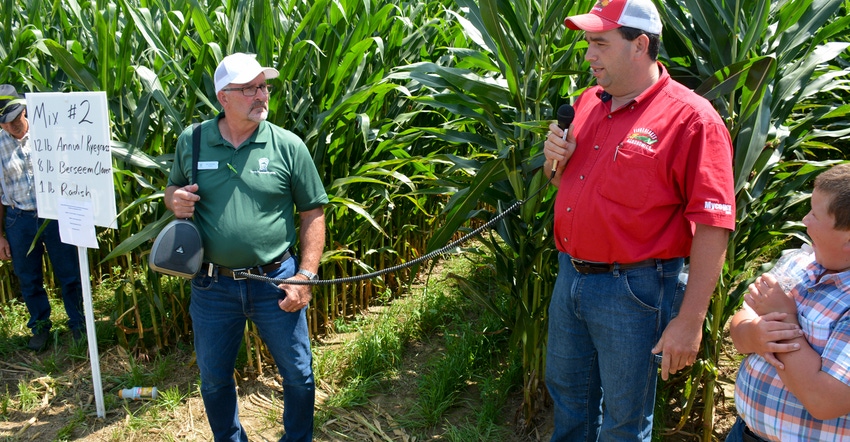
Elizabethtown, Pa., farmer Jim Hershey thought he was getting a great interseeded cover crop last year.
“Last year, we thought things looked really good,” he said at a recent no-till field day held on his farm.
Then came the rains in late July.
“By the end of last August it was starting to die off. There was nothing left,” he said.
Was it the rain, or was it the residual from the Rango, Atrazine and Acuron he used earlier in the season? He doesn’t have the answers, but he’s not giving up on the idea of interseeding, even after struggling the past five years.
“We’ve had inconsistent results from interseeding in southeast Pennsylvania,” he said. “So we think it has something to do with the local climate or geography.”
This year, Hershey’s trying something different. He’s experimenting with three different cover crop mixes in replicated 30-inch and 30-60-30-inch corn plots. The Pioneer P0574 corn was planted April 24. The plots were sidedressed May 31, and the interseeding was done June 4.
The mixes are as follows:
8 pounds of orchardgrass, 10 pounds of cow peas, 4 pounds white clover, 4 pounds berseem clover and 1 pound of radish
12 pounds annual ryegrass, 8 pounds berseem clover and 1 pound of radish
8 pounds orchardgrass, 12 pounds black oats, 4 pounds sunflower and 4 pounds berseem clover
The plant population in the 30-inch rows was 37,000 an acre and higher in the 60-inch plots.
A 12-row interseeder was used for interseeding.
Using less herbicide
One thing Hershey did differently this year was use less residual herbicide. During a recent tour of the test plot on his farm, he pointed out that the first 90 feet of the 3-acre plot had a residual herbicide while the rest of the plot did not.
Looking at the plot, the covers were growing better where herbicide wasn’t applied, especially in the first couple of feet. Growth was similar in the 30-inch and 30-60-30-inch plots.
This is Hershey’s second year growing in 30-60-30-inch plots. The whole idea behind wider rows is to allow more sunlight for the cover crops to grow. Hershey said that he saw better cover crop growth in the wider plots last year, but his corn yields were off 17 bushels an acre compared to the 30-inch plots.
Still, he’s open to making a sacrifice in his corn if he can get his covers established early.
“When you look at 17 bushels, I would say that I’m happy to give up 17 bushels to have a good stand of cover already established,” he said, especially when interseeding grain corn. “You have to get the cover established … because often it becomes too late to get something established.”
But he still has questions. Will the cover crops survive into fall? And how will his corn yield be affected? Hershey also has concerns over not using residual herbicides over large acres of corn, even though he does rotate his fields with other crops.
Success with shorter-day corn
Jonathan Martin, a farmer in New York state, said he's been interseeding for five years.
He uses shorter-day corn — 95-day and 105-day corn — to ensure plenty of sunlight gets into his plots, and he believes this has lots to do with his success.
Using Calysto or Atrazine hasn’t been a detriment on his farm, he said, although some crops do better than others
“Radishes sometimes didn’t survive and ryegrass did, or vice-versa,” he said.
Whenever he backed off spraying, though, the cover crops did come through better. Much of the interseeding he’s done is on large acres of corn silage, he said.
Hershey uses up to 113-day corn on his farm, but he said he’s been going to shorter-day corn the past few years, too.
Spreading instead of drilling
Farmer Mark Rohrbach of M&A Farms near Catawissa, Pa., said he’s used a Vicon 3-point-hitch twin spreader for spreading seeds in his plots. He said he’s seen better results in soybeans than corn, especially when applying to soybeans that are starting to mature.
With corn, it’s been a learning curve.
“The biggest thing is you have to get on early,” he said, ideally when the crop is between 2 and 4 inches tall.
Rohrbach, who also mixes and sells cover crops, said farmers should focus on covers that can get established when broadcast — buckwheat, radishes, rye and wheat are good choices, he said.
Another thing he’s been doing is mixing cover crops with urea or ammonium sulfate for application during sidedress.
Rohrbach said farmers should switch to shorter-season corn or soybeans and lower their plant populations to ensure maximum sunlight faster.
“Don't consider these to be a weed, consider it to be a benefit to your crop,” he said. “And if you're growing something like buckwheat or radish, it's not going to be a detriment to your corn.”
Have a plan
Interseeding must work within the overall farm’s goals.
For Doug McConnell, who farms 400 acres in Zanesville, Ohio, getting cover crops established early is crucial for producing forage for his Jersey heifers.
He interseeded cover crops last year in 30-inch rows with a 3-point drill. He saw mixed results with the end rows growing well.
The experience gave him the confidence to try again this year. He’s dropped his corn plant populations and is comparing 60-inch rows to 30-inch rows to see which ones do better. The cover crop is a nine-way blend of seeds including pearl millet, which he said has grown to more than 18 inches tall.
“So far, we’re seeing some pretty good results,” he said.
Only time will tell, though, if these farmers see the success they were hoping for.
About the Author(s)
You May Also Like






